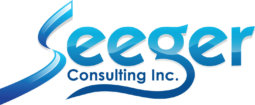Marketing automation is a $6.6 billion industry and growing fast. Yet, 54% of companies say they’re not getting full value from the platforms they’ve invested in. Could you tell me why? Because they chose a tool based on features—not fit.
This post will show you how to select a platform that aligns with your team, your tech stack, and your growth trajectory—so your automation doesn’t become “shelfware”.
How do I choose the best marketing automation solution for my business?
We have created a framework that helps businesses choose the marketing automation solution that will work for you today. This framework will guide your business to automation tools that will create faster growth and scalability in the future.
A 10-step framework to select the right marketing automation software for your business!
- Strategic Fit
- Ease of Use & Adoption
- Integration & Data Sync
- Segmentation & Personalization Power
- Multi-Channel Automation
- Analytics & ROI Tracking
- Scalability & Complexity Management
- AI and Predictive Automation
- Customer Support & Community
- Cost-Effectiveness and ROI
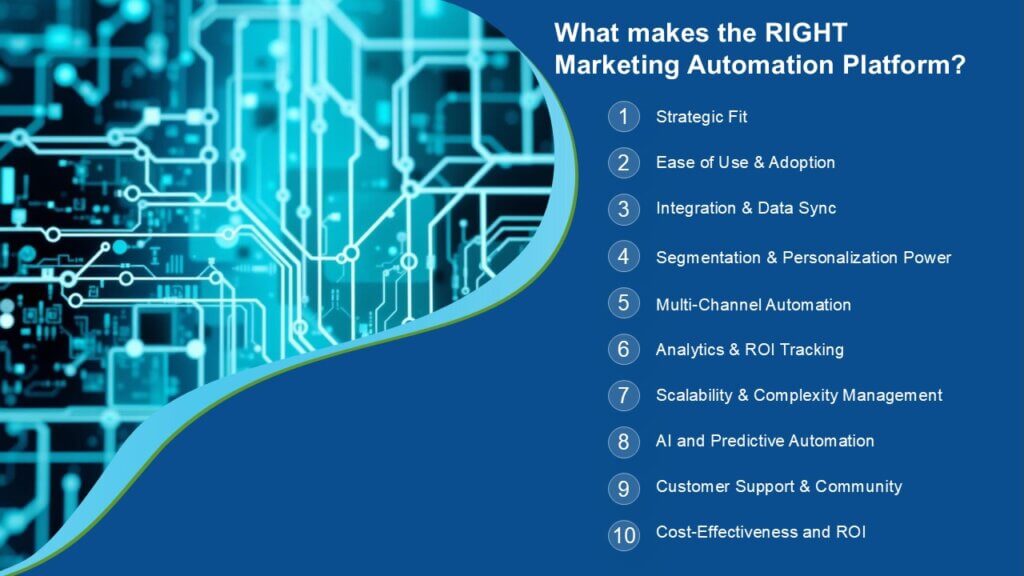
Strategic Fit of your marketing automation software
When selecting a marketing automation software platform, one of the most strategic questions to ask is: does it align with your business goals and marketing maturity? The right tool should not be a siloed side project—it should be a core driver of your growth strategy. For example, Marathon Health implemented automation and saw a staggering $4.5 million in new pipeline revenue within just two months, along with a 211% increase in buying growth. Such an impact only occurs when a company tightly integrates automation into its revenue engine, not as an afterthought.
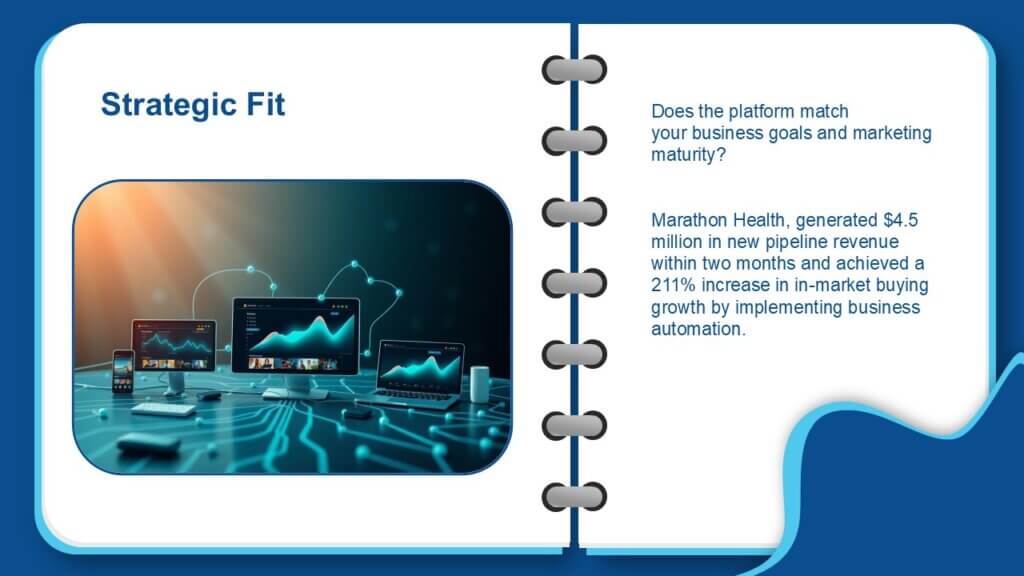
Your market maturity and your company's position within it should inform your platform choice. Are you scaling in a crowded space? Are you entering a new vertical market? A platform suited for lead generation in a fast-moving B2C funnel may fall short in a long-cycle B2B sale that requires account-based marketing (ABM) strategies. Similarly, a nonprofit focused on donor nurturing will have fundamentally different automation needs than a SaaS firm selling to law practices. Consider tools like Clio, which excel at practice management, but may not deliver the level of lead automation or nurturing that a growth-driven legal tech firm needs.
It’s also essential to match the platform’s life expectancy with your own. Don’t choose a lightweight tool that will bottleneck your team in a year, nor an enterprise behemoth that overwhelms a startup. And avoid the common mistake of chasing an “all-in-one” platform that promises to do everything—most end up mediocre at most things and great at none. Instead, choose a strategic stack of tools: tools that integrate well, fit your team’s capabilities, and are built for your future, not just your present.
In short, marketing automation is not a software decision, it’s a strategic alignment decision. The platform you choose should amplify your vision, support your growth stage, and fit the way your buyers buy. Anything less, and you’re building on the wrong foundation.
Ease of Use & Adoption is critical in the best marketing automation software.
Consider the case of 6clicks Case Study, a GRC software company that achieved an 806% increase in operational efficiency by implementing an integrated marketing platform. Their success wasn’t just about the software—it was about choosing a platform that matched their team’s workflow and required minimal retraining. The onboarding process was seamless because the platform fit the team's existing capabilities and didn't overwhelm them with unnecessary complexity. They didn’t need to replace team members or rely solely on external agencies; instead, they built operational growth through strategic alignment.
When evaluating platforms, compare your team's strengths with the platform’s usability curve. Will it require weeks of paid setup or an ongoing relationship with a high-cost agency just to stay functional? Or can your existing team take ownership with minimal friction? And add functionality as you grow.
It helps to consider redundancy planning—how easily can new team members onboard if someone leaves? A platform that demands constant retraining or has a steep learning curve will eventually slow you down.
Skipping team buy-in is the biggest misstep. If the people responsible for implementing, running, and improving the automation aren’t on board from day one, your investment could become shelfware.
In short, the best platform is the one your team will use consistently and confidently. Simplicity, clarity, and capability need to align—or the platform won’t scale with your ambitions.
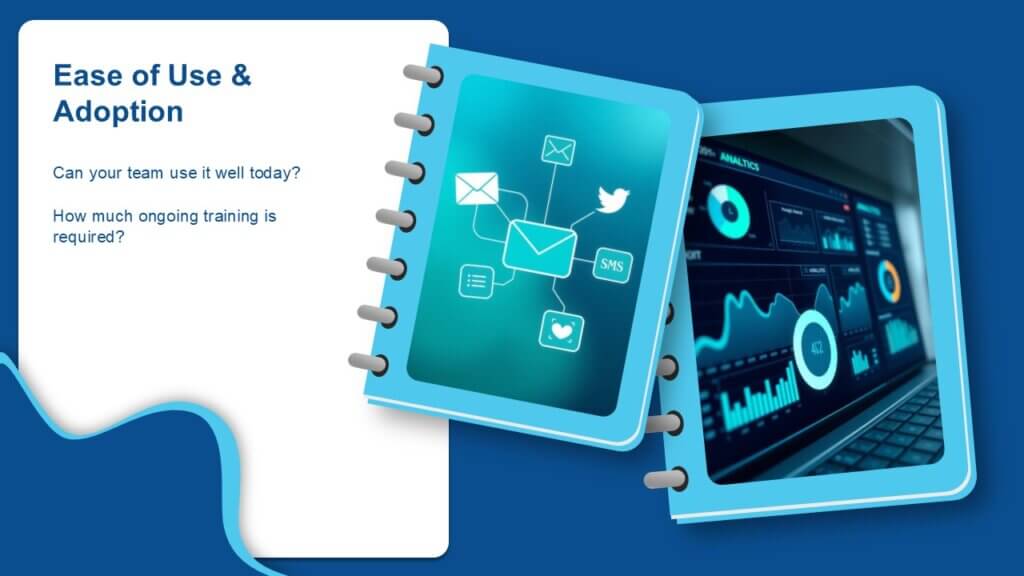
Integration & Data Sync means a better Marketing automation workflow
Marketing automation doesn’t operate in a vacuum. For it to drive results, it must connect seamlessly with your existing tech stack—especially your CRM, other marketing tools, website, analytics tools, and communication platforms. Yet one of the most common (and costly) mistakes teams make is overlooking data sync and system interoperability during the selection process. When your marketing automation tool doesn’t integrate smoothly, you risk duplicated records, outdated data, and misaligned communication across marketing and sales teams.
In fact, studies have shown that companies integrating their CRM with their marketing automation see a 30% increase in sales win rates (source: b2brocket.ai). This is because successful marketing automation integration enhances customer visibility and streamlines workflows, allowing marketing and sales to act on real-time insights rather than stale reports or manual updates. It also eliminates the busywork that clogs pipelines—freeing up your teams to focus on what matters: strategy and relationships. Automation saves time, which supports more sales and marketing success. Effective marketing automation also saves money and shortens the sales cycle.
Think beyond the software—consider the people. Different departments often use different tools, and your automation platform must bridge those silos, not deepen them. During the pandemic, for example, teams rapidly changed how they worked—remote-first workflows, Slack integrations, and self-serve data access became essential. If your automation tool doesn’t support those evolving processes, it’s already outdated.
When you consider the life expectancy and redundancy of every tool in your stack, will your automation tech stack still serve its purpose two years from now? Or will it become redundant once another team adopts a conflicting tool? Establish Standard Operating Procedures (SOPs) for setting up and maintaining integrations—because the mistake isn't just choosing the wrong tool; it's also failing to manage how it connects to the rest of your ecosystem.
The best-fit platform will work with you, your data, your teams, and your growth strategy. Integration isn’t optional. It’s infrastructure.
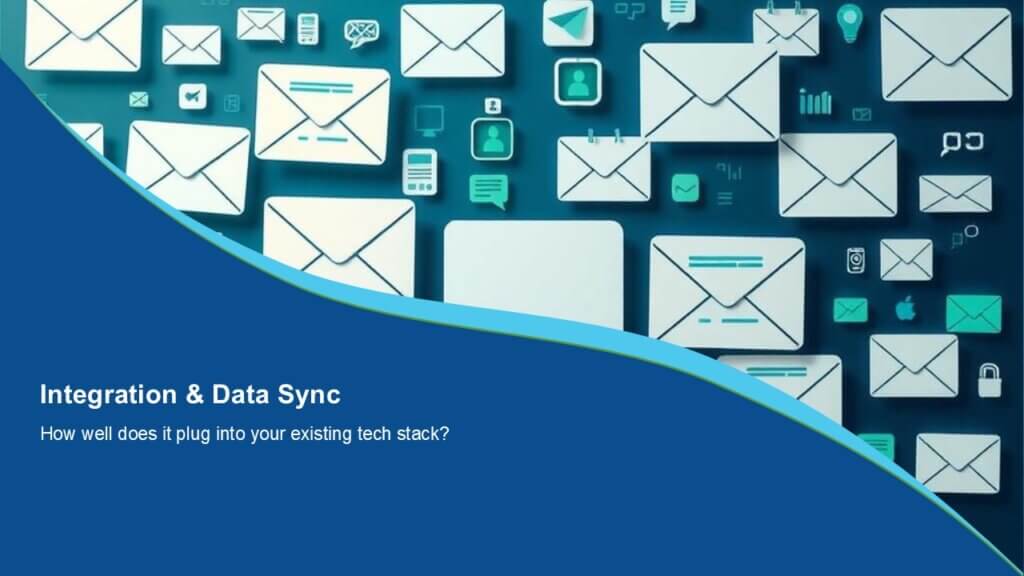
Segmentation & Personalization Power is valuing the customer experience.
One of the greatest advantages of marketing automation isn’t just efficiency, it’s the ability to deliver personalized messaging at scale. In an era where attention is fragmented and trust must be earned, personalization is no longer a “nice-to-have”. Personalization is a performance driver. According to Epsilon research, 80% of consumers are more likely to purchase from a brand that provides a personalized experience. That stat alone makes a compelling case for tools that can deliver dynamic content based on behavior, preferences, and context.
But true personalization goes beyond just dropping a first name in an email. It involves smart segmentation based on demographics, psychographics, and firmographics. It isensuring that the messaging resonates with each audience segment, whether you're targeting decision-makers at enterprise firms or SMB end users on mobile.
It is automating your message across channels—email, SMS, push notifications, even in-app messaging—so that your content remains contextual and cohesive throughout the buyer journey.
A great example of this in action is Dynamic Yield, (dynamicyield.com) which leveraged a personalization strategy to guide visitors from the awareness phase through to conversion with tailored experiences. Their implementation of targeted content based on user behavior significantly improved engagement and conversion rates—proving that thoughtful segmentation and real-time content adjustments work when done correctly.
However, one common misstep is assuming a single tool can do it all. No one platform can master every digital marketing channel out of the box. The key is choosing a platform that integrates well with your data sources and supports dynamic content delivery across your core channels. Because scaling personalization isn’t about gimmicks—it’s about relevance, resonance, and responsiveness at every touchpoint.
Effective Marketing automation tools work with your existing processes, but can automate routine marketing tasks that will keep your business top of mind with your prospects.
Multi-Channel Automation is a best practice.
Is Your Channel Strategy Aligned—or Just Busy?
Marketing automation isn’t just about sending more messages—it’s about coordinating the right messages across the right channels to guide your buyer toward a clear decision. That’s why leading companies are embracing multi-channel strategies. According to industry data, 65% of marketers use email automation, while combining email, SMS, and social media has shown to boost engagement rates by 20%. Meanwhile, 74% of users prefer interacting with chatbots to get fast answers to basic questions, especially during product research or post-sale service. These stats are clear: your audience expects seamless, relevant communication across platforms, and marketing automation should be the engine that makes that happen.
The key to success is coordination and clarity. If your messaging strategy lacks a central focus, multi-channel marketing will quickly devolve into noise. This is especially true when sales and service teams operate in silos, or when project management teams prioritize campaign deadlines over sales enablement. The result is fragmented outreach that confuses prospects and wastes internal resources. One common mistake is letting one team own the automation strategy without cross-functional alignment, leading to beautifully executed campaigns that don’t convert—or worse, contradict sales outreach.
Take VHT, a contact center SaaS company, as a cautionary and inspiring example. They partnered with Bay Leaf Digital (bayleafdigital.com) to implement a coordinated multi-channel marketing strategy—email, SEO, content, and more. The results were a 36% increase in organic traffic and a 24% jump in qualified corporate leads. What made it work was the alignment between messaging, departments, and goals.
In a true multi-channel strategy, every touchpoint needs to reinforce a central message and customer journey. Whether it's an email about a new feature, an SMS alert about an expiring offer, or a chatbot answering pre-sales questions at midnight, it needs to be consistent. It’s not just about being everywhere. It’s about making everywhere feel like one cohesive conversation.
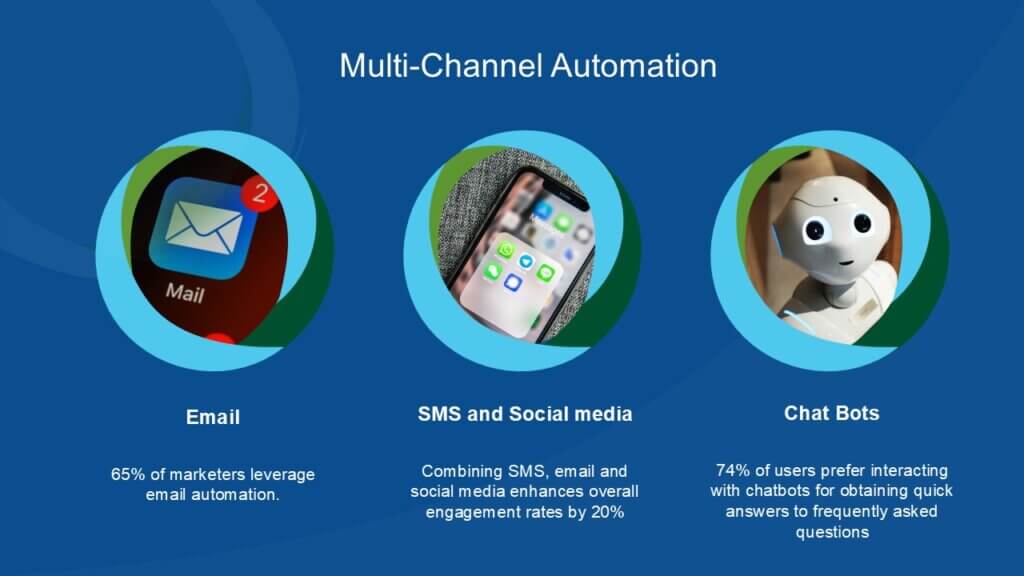
Analytics & ROI Tracking for your marketing campaign.
Analytics & ROI: Are You Measuring What Moves the Needle?
In the world of marketing automation, having access to analytics isn't enough—what you track and how you act on it determines your success. To truly support growth, align your analytics strategy tightly with your organizational goals, not just marketing KPIs. That means setting up your platform to track not just clicks and opens, but pipeline contribution, cost per lead, and revenue generated. Without that alignment, it’s easy to fall into the trap of over-reporting vanity metrics that don’t inform meaningful decisions.
Verato, a B2B healthcare SaaS provider, implemented a well-integrated multichannel strategy with clear performance tracking, and achieved a 75% increase in leads and a 312% reduction in cost per lead. (blog.uncommonlogic.com) Those results didn’t happen by chance—they resulted from building automations with analytics in mind from day one. The ability to see what was working (and what wasn’t) gave them the insight to refine campaigns in real time and make smarter decisions.
Data-driven optimization—like A/B testing subject lines, CTAs, and workflows—only works when your reporting infrastructure supports it. That means simplifying dashboards, selecting the right KPIs, and ensuring you’re tracking metrics that guide strategy, not just satisfy curiosity. Remember: 80% of your sales might come from just 20% of your customers. If you’re not reporting on the right segments, you’re likely optimizing for the wrong audience.
And here’s a common mistake—complexity masquerading as insight. If your team is drowning in data but unclear on what actions to take, your analytics setup isn’t helping. Prioritize clarity over clutter when building your marketing automation system. Align what you measure with what your business values, and make sure your analytics help you do the one thing that matters most: make better decisions, faster.
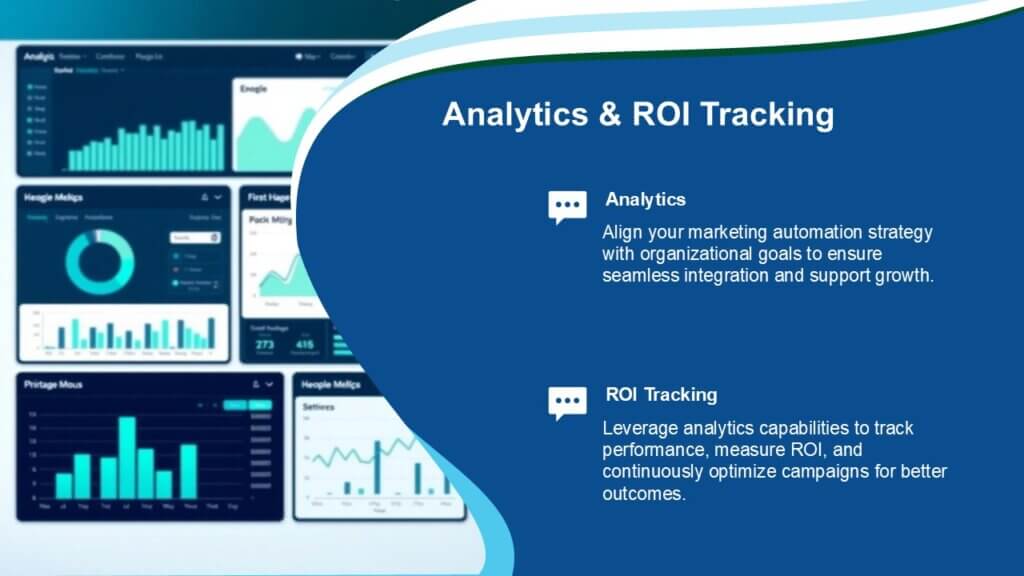
Scalability & Complexity Management is the key to grow your business.
Scalability and Complexity: Will Your Marketing Automation Tools Grow With You—Or Hold You Back?
As your company grows, so do your marketing demands. The question isn’t just whether your systems work today, it’s whether it will still work when you’ve doubled your lead volume. Or will it work when you have expanded your service offerings, or onboarded five new team members? Scalability is about future-proofing your tech stack. The right platform should scale with your customer base, campaign complexity, and internal workflows—without requiring you to start from scratch every 12 months.
Take the example of a Utah-based SaaS firm that partnered with Leadlytics Labs. (leadlyticslabs.com) By optimizing its operations, by getting all teams to see a comprehensive view and control of the whole customer journey, the company dramatically improved its marketing efficiency. But more importantly, it created a scalable framework—one that could handle increasing numbers of clients, leads, and campaigns without failing under pressure. That’s the difference between growth readiness and reactive scrambling.
As marketing operations mature, they typically require more than just emails and lists. You’ll need integration with CRM, lead scoring systems, dynamic content, segmentation models, and eventually dedicated operations or analytics team members. Choosing a tool with limited capabilities—because it’s easy now—can mean painful migrations later. Think about the difference between Mailchimp and Marketo. Mailchimp might be perfect for a small team with a short sales cycle. But if you're in complex B2B sales with multiple buyer journeys, you’ll quickly outgrow it and hit technical ceilings.
And here's the trap: the “shiny object syndrome.” Many companies buy flashy tools packed with features they’ll never use—or worse, that don’t align with their actual goals. These tools often end up underutilized and eventually replaced. Instead of chasing trends, seek platforms with a clear life cycle fit: tools that match your business size today, but have room to support where you're headed next.
In short, scalability isn’t just about volume. It’s about managing complexity without adding chaos. Choose tools that evolve with you, not ones you’ll outgrow just as your momentum kicks in.
AI and Predictive Automation is the right way to automate your marketing.

AI in Marketing Automation: Is It Fancy or Useful?
Marketing is in constant motion. Buyer behavior shifts, channel algorithms evolve, and what worked last quarter might not work tomorrow. That’s why AI-powered automation isn’t a luxury—it’s becoming a necessity. But not all AI is created equal. When evaluating a marketing software, the question isn’t just does it have AI?—it’s where and how is that intelligence actually being used?
Take the partnership between IBM and Scuderia Ferrari, where AI was used to enhance fan engagement through a reimagined mobile experience (axios.com). IBM’s platform transformed complex datasets—like performance telemetry and driver stats—into personalized, real-time insights that kept fans connected and immersed. This wasn’t AI for show; it was AI driving strategic outcomes by tailoring experiences at scale. And that’s the distinction marketers must pursue today.
Teams are too often seduced by shiny AI features such as chatbots with witty intros and automated copy generators that sound good but don’t convert. The real value lies behind the scenes: in predictive analytics, intelligent segmentation, behavioral scoring, and automated decisioning. Does the platform help you send campaigns when a lead is most likely to convert? Can it suggest the next best action based on a customer’s browsing patterns or lifecycle stage? (Something that the Keap email marketing platform has built its reputation on for 15 years!)
The biggest mistake is choosing flash over function. AI should empower marketers with clarity and foresight, not just automate tasks. Consider platforms where AI enhances performance—not just appearance. Because in the end, useful AI doesn’t just make things look smarter. It helps you market smarter.
Customer & Community Support is part of a great automation tool.

Support, Training, and Community: Is It Onboarding or Just an Upsell?
When evaluating a marketing automation tech stack, one of the most important—but often ignored—questions is this: what kind of support will you receive after you sign the contract? Too many platforms blur the line between true onboarding and thinly veiled upsells. They might promise “getting started help,” but real training, implementation guidance, or strategy consultation will cost extra through paywalled support tiers.
Understanding the distinction between onboarding and actual training is crucial. Onboarding is often just a technical walkthrough—how to log in, where to click, how to build a basic email. Real training is ongoing, strategic, and grounded in use cases: how to segment, optimize workflows, and drive conversions with your specific audience. If your team needs to rely on agencies or premium support packages to get through everyday tasks, you're not building internal strength—you’re renting it.
Another mistake is overlooking the value of the platform’s community. A strong user community or partner network can be one of your biggest assets—offering templates, troubleshooting advice, workflow inspiration, and even peer reviews of new features. Yet often, buyers don't explore whether a platform has this kind of ecosystem until they hit a wall. And if the answer is no, your only path forward might be vendor support … which may not offer all that you need.
- · Before you choose your next platform, ask the hard questions:
- · Is the onboarding included or just a demo?
- · Will your team get access to practical, role-based training?
- · Does the platform have a thriving user community?
And most importantly: Is the goal to empower your team—or partner with someone that can empower your team? Both have advantages and costs that need to be considered.
Support is about enabling success. Some companies choose partnerships to achieve success and some want to keep it in house … just be clear when you sign up.
Cost-Effectiveness and ROI best practices.
Does the Platform Provide Value for Its Cost?
For marketing automation, one of the biggest mistakes companies make is focusing on cost instead of value. Choosing a tool because it’s cheaper—or because it promises everything under one roof—often leads to stalled adoption, missed opportunities, and wasted spend. The real question should be: how quickly can this platform deliver a measurable return? Are we talking about value in days or months—or years?
Take the case of Public, a leading retailer that adopted MoEngage (MoEngage Case Study) to improve its outreach. In just six months, they achieved a 27x ROI (Return on Investment). That’s not just impressive; it’s proof that with the right strategy and tool, automation can drive serious performance in a brief window. They didn’t get there by chasing features, they focused on what mattered most. They focused on re-engaging millions of dormant users, streamlining their messaging strategy, and building a dashboard that helped them optimize in real time.
Marketing automation should act as a focus multiplier. The best platforms help your team zero in on the high-impact actions—nurturing the right leads, automating the repetitive, and making smarter decisions backed by data. A common mistake is misjudging the total cost to the ROI equation. Licensing is just the starting point. You also have to factor in training, support, team bandwidth, and how long it takes to get to full operational use.
Ultimately, the right platform will pay for itself—not just in efficiency, but in pipeline, conversion rates, and long-term growth. So don’t just ask what it costs—ask how quickly it creates value, and how well it keeps compounding over time. Because the goal isn’t just automation. It’s acceleration.

Consent Management is for the smart marketer.
Compliance Isn’t Optional—It’s a Competitive Advantage
As marketing automation grows more sophisticated, so do the expectations of privacy, consent, and compliance. Whether you're running campaigns in North America or across global markets, regulations like GDPR, CAN-SPAM, and CASL absolutely apply in the B2B space. That means your automation platform must go beyond sending emails—it needs to handle consent management, unsubscribe logic, and email deliverability infrastructure with care and precision.
From SPF and DKIM authentication to suppression list enforcement and permission tracking, compliance is more than just a checkbox. It’s how you protect your sender reputation and ensure your messages land in inboxes. Platforms that don’t offer built-in compliance features—or make them difficult to manage—put your business at risk for fines, lost credibility, and declining engagement rates.
And here’s a key point: don’t rely on a single platform for accuracy. No tool is infallible. Reporting rules change constantly, making the specifics of what's tracked and how accurately it's tracked subjective. And often platform specific statistics won’t match comparatively, because the software tools are using different tracking, reporting and updating methods. Or they performed them at different intervals.
Every year, the stakes get higher. The brands that build privacy and permission into their automation strategy will be the ones that win in both performance and perception. Because in a data-driven world, how you use data matters just as much as what data you collect.

Final Strategic Considerations
Buyer Journey Fit: Does It Nurture Your Prospect or Lose Them?
In B2B marketing, automation doesn’t just deliver messages—it shapes experiences. One of the most overlooked, yet critical, considerations is whether the platform you're choosing aligns with your buyer’s actual journey.
- · Can it engage cold prospects with awareness content, not just send promotional blasts?
- · Does it allow for nurture at the consideration stage, with tailored workflows based on engagement behavior?
- · Does it support triggered actions that lead naturally into conversion opportunities like demos or consultations?
- · And does it enable post-sale engagement, customer onboarding, and retention automation?
If your platform cannot move prospects from problem awareness to solution consideration to decision and advocacy—it’s not just inefficient. It’s actively costing you sales.
Every touchpoint should feel intentional, timely, and relevant—because modern B2B buyers expect it.
Your chosen automation system should allow you to map and operationalize your buyer journey, from first click to final decision. This means:
- · Flexible segmentation
- · Behavioral triggers
- · Content personalization
- · Stage-based reporting
- · And seamless hand-offs between marketing and sales
Without this alignment, you risk pushing the right message at the wrong time—or worse, pushing the wrong message altogether.
The right platform doesn’t just automate tasks—it orchestrates trust.
Make sure your tech matches your buyer’s reality. Because the buyer’s journey isn’t linear—but your automation can be intelligently responsive to it.
The SWOT Lens for how marketing automation works.
At the end of your evaluation, ask yourself one powerful, clarifying question:
“Does this platform actually fit who we are and where we need to go?”
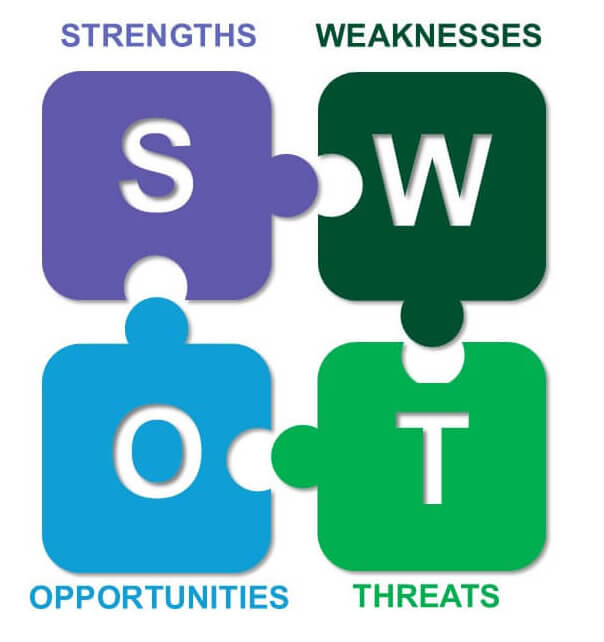
The best marketing automation solution won’t just offer shiny features—it will align with your organization’s strengths. This means looking through the lens of your SWOT: Strengths, Weaknesses, Opportunities, and Threats.
- · If it doesn’t play to your strengths (like existing content libraries, technical skill sets, or strong sales alignment),
- · If it doesn’t support or improve your weaknesses (such as limited segmentation ability, weak CRM data, or poor nurture workflows),
- · If it doesn’t clearly create new opportunities (like automating tasks, dynamically connecting with contact, scaling nurture campaigns, or accelerating lead qualification),
- · And if it doesn’t help mitigate threats (such as competitor advantage, declining engagement, or compliance risk)…
…then is it truly the best fit?
Technology should be a multiplier. The right tool amplifies what you do well, bridges the gaps where you struggle, opens doors you couldn't access before, and helps shield you from what could go wrong.
A mismatched platform will cost you time, momentum, and credibility—regardless of its market share or review scores.
The most strategic choice will fit not just your marketing stack, but your strategic stack. It should feel less like a vendor decision and more like choosing the right co-pilot(s) for your growth journey.
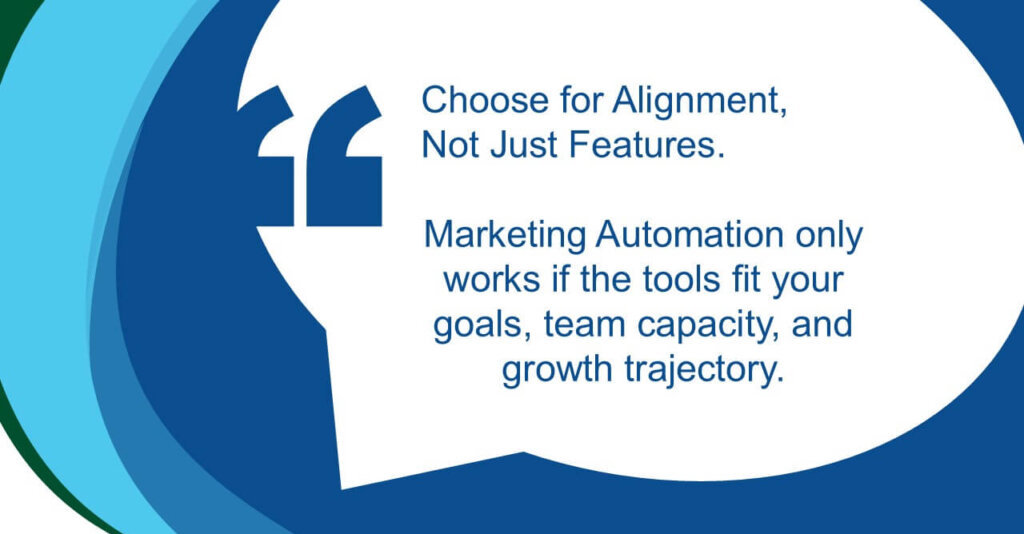
Ready to transform your marketing strategy?
If you’re tired of guessing which tool to choose, overwhelmed by underperforming platforms, or ready to take your marketing automation to the next level—now’s the time to act. A well-executed marketing strategy doesn’t just save time. It drives measurable growth, sharpens your focus, and gives your team the power to scale with confidence.
Whether you’re just beginning your automation journey or looking to optimize a system, that’s already in place, we can help you:
- · uncover the gaps,
- · identify the right-fit tools, and
- · design a strategy built for ROI—not just activity.
Let’s inspect your current marketing operations, align them with your goals, and craft a smarter path forward.
📅 Book your strategy session today and let’s build a system that works just as hard as you do. Because transformation doesn’t happen by chance—it starts with the right conversation.
FAQ's about marketing automation
What is the significance of choosing the right marketing automation platform?
Choosing the right marketing automation platform is crucial because it directly impacts your organization’s ability to effectively manage its marketing process. An appropriate platform can enhance your customer experience by enabling personalized communications, improving lead nurturing, and streamlining marketing and sales alignment. Conversely, selecting the wrong one can lead to wasted resources, inefficient workflows, and ultimately, a negative return on investment (ROI) for your marketing automation strategy.
How does a poor choice in marketing automation software affect your budget?
A poor choice in marketing automation software can lead to additional costs beyond the initial investment. Organizations may face increased operational expenses due to the need for additional tools to fill gaps left by the inadequate platform. For example, if the software lacks essential features like email marketing or automated marketing capabilities, you may need to invest in separate solutions, which can quickly add up. Additionally, the time spent training staff or troubleshooting issues can further inflate costs.
What are some common pitfalls when selecting marketing automation tools?
Some common pitfalls include failing to clearly define your marketing automation strategy before selection, neglecting to consider user experience, and underestimating the importance of integration with existing systems like your CRM. Many organizations also overlook the necessity of vendor support and ongoing maintenance, leading to frustration and lost productivity down the line.
How can the wrong choice in marketing automation impact your customer journey?
The wrong marketing automation choice can disrupt the customer journey by delivering irrelevant messages, failing to nurture leads effectively, or creating a disjointed experience across different marketing channels. This can result in potential customers feeling disconnected from your brand, ultimately impacting their decision to engage or convert.
What role does email automation play in a successful marketing campaign?
Email automation is a vital component of a successful marketing campaign as it allows for timely and personalized communication with your audience. An effective automated marketing strategy leverages email marketing to nurture leads through personalized content that addresses their specific needs and behaviors. Without adequate email automation, you risk missing opportunities to engage and convert potential customers
Q: What are the benefits of marketing automation?
A: The benefits of marketing automation include increased efficiency by automating repetitive tasks, improved lead nurturing through personalized messages, enhanced customer engagement with relevant content, and better tracking of marketing ROI through data analysis.
Q: How does marketing automation help streamline my marketing efforts?
A: Marketing automation helps streamline your marketing efforts by allowing you to automate email campaigns, manage customer data, and segment your audience effectively, ensuring that your marketing messages reach the right people at the right time.
Q: What types of marketing automation can I implement for my business?
A: There are several types of marketing automation, including email marketing automation, social media automation, lead generation tools, and customer relationship management (CRM) systems that help you nurture leads and manage customer profiles.
Q: How can I personalize my marketing messages using automation?
A: Marketing automation allows you to personalize your marketing messages by using customer behavior data and customer profiles to tailor your communications, ensuring that your messages are relevant and engaging to each individual recipient.
Q: What are some marketing automation best practices I should follow?
A: Some marketing automation best practices include segmenting your audience for targeted marketing, testing and optimizing your campaigns regularly, integrating with your CRM system, and continuously analyzing customer data to improve your strategies.
Q: How does marketing automation support lead nurturing?
A: Marketing automation supports lead nurturing by enabling you to automate follow-up emails, track interactions with your content, and send personalized messages that guide leads through the sales funnel based on their behavior and engagement levels.
Q: What role does customer data play in marketing automation?
A: Customer data is crucial in marketing automation as it helps businesses understand customer behavior, preferences, and demographics, allowing for more effective targeting and personalization of marketing messages.
Q: Can marketing automation improve my marketing ROI?
A: Yes, investing in marketing automation can significantly improve your marketing ROI by optimizing your marketing activities, reducing costs through automation, and enhancing the effectiveness of your campaigns, leading to higher conversion rates.
Q: How can I learn about marketing automation effectively?
A: You can learn about marketing automation effectively by attending webinars, reading industry blogs, participating in online courses, and experimenting with marketing automation software to understand its features and benefits firsthand.
Q: What common mistakes should I avoid when using marketing automation?
A: Common mistakes to avoid include neglecting to segment your audience, failing to personalize messages, not analyzing results regularly, and automating too much too quickly without a clear strategy in place.
